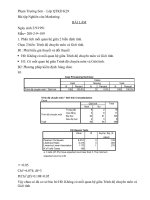Bài tập cá nhân marketing management
Bạn đang xem bản rút gọn của tài liệu. Xem và tải ngay bản đầy đủ của tài liệu tại đây (106.32 KB, 9 trang )
BÀI TẬP CÁ NHÂN MARKETING MANAGEMENT
CONTENT
1/ It can be explained below
(a) Manufacturing concept:
Economicstandpoint: Manufacturing is the process ofcreating productsandservices
that meetthe needsof society.
Marketing standpoint: Manufacturing is activitiesin orderto createvalueand
benefitsforcustomerswhichto achievetargets of profit for the businesses.Thus,
according to marketingstandpoint,activitieswhich do notbring valueandbenefit
tocustomersarenot considered to be the production. (Philips KotlerMarketingbook)
*In essence, the manufacturing is the processes oftransforming the inputs, then,
changingthem intothe outputsunder the form ofproductsorservices.
(b) Product line:
The product lineis a series of the sameproductsabout the structure,
function,shape, and characteristicthat can be readilyidentified.
For example, computershave a lot ofcategories,so that customersareaware
ofthemanufacturer. Therefore, everycompanyproducesitsownacertainproduct
linessuch as Dellx130, Sony, Acer5100, Hp5600, Nokiax, y,z, iPhone5S.
(c) Product expansion:
The effectiveness in marketing requires businesses not only to develop good
products, attractive product pricing and splendid support to target customers, but
also to positively communicate with the potential customers. All of the activities of
a business in communication with customers create a mix product expansion of the
business. This mixture consists of a unique combination of advertising, direct
sales, sales promotion and public relations activities that businesses use to promote
the objectives of their own products expansion and marketing. Then, the first step
in the process of development of mix product expansion is clearly defined target.
(d) Social marketing concept:
According to Philip Kolter in 2002, there is a definition about social marketing. It
is said that social marketing isthe use ofthe marketing principlesandtechniques in
order to influencetheirtarget audiencetoaccept, refuse, modify,
orremoveacertainvoluntaryaction, whichisusefulfor individuals, groups orsociety.
According to Alan Andreasen in 1995, there is a definition more academic. It is
said that Social marketingisthe application ofmarketing
techniquesintobusinessthroughthe analysis, planning, implementation
andevaluationofprograms which aredesignedto influence thevoluntary
behavioroftargetgroups in orderto bringthegreatnessto themandsociety in
whichtheyare members.
According to Nedra Kline Weinreich in 1999, there is a simple definition of social
marketing. It is said that social marketingistheuse ofmarketing techniquesto
encouragement aboutconsensus aboutacertainbehaviorto improvehealth
andhappiness for every member in the society.
2/ Explain difference in marketing concept, along with suitable examples.
Marketingisagoodproductis soldinconvenient placesforthe right peopleto buyfora
reasonable price. (Adcoketal).
For example, abusinessenterprise which productsbranded goodsbrings its own
goods to guests inrural areas having low income. This
activityofbusinessenterpriseproved that it does notunderstand about marketing. It
doesnotsellwhatthe customer needs, it just sells onlywhatthey have.
Marketingistheactivityaimedtowards to the satisfying of customerneedsand
wantsthroughthe processes of interaction exchange. (Kotler1980).
For example, that continuous improvementactivitiesin orderto bringproductsto
customersmorebenefits rather than old timesisdoneincorporatemarketing activities.
For example,EVN is equipped withelectronicgalvanometer
forcustomerstobemorefavorable, notwasting of time forwritinga monthlyindex;
besides, it increases theconfidence ofcustomers towardsEVN about themonthly
amountof electricity. That ismarketing. To achievethis, theremust be surely from
EVNstaff that working inmarket research, customer researchandeffectivemarketing
strategy.
Marketing is a task in the organizational structure and a set of processes in order to
create, exchange, convey value to customers, and for managing customer
relationships in different ways to bring the benefits to the organization and the
members of the General Meeting of Shareholders. (American Marketing
Association - American Marketing Association, 2008)
For example, Honda is always a pioneer in the introduction of new product lines,
which is known the 2-wheel vehicles in Vietnam. Honda has improved from
designs, modern technology (Product), to cheaper price (Price). Furthermore,
nowadays, people want to buy HONDA wherever in the city (Place). When talking
to the 2-wheel vehicles, Vietnamese wants always referred to the name of HONDA
SUZUKI whether it is or what other effects. This evidence shows that Honda has
done good job at promotion (Promotion). Eventually, what causes the development
of HONDA today, surely everyone can understand.
3/ Explain the market segmentation and suitable examples.
Market segmentationortargetmarketingisthe opposite concept ofmass
marketingandmarketingvarious products. The objective ofmarket
segmentationinmarketingmarketis todivide itintosmallersegments, easy
identification in order to catch the demand andrespondmoreeffectively without any
trouble. Becauseresources of the companyarelimited, they cannotmeetallmarkets;
furthermore, every businesshas adifferentstrength which is also adifference in
comparison with thecompetition. Hence, toeffectively meet the needsof the market,
businessesshouldsegmentthe market, choosethetarget marketin order tocompete
effectivelyandsurvivesustainablyrivals.
For example, inthe automotive market, wecan see thatinthehighestsegment, it has
Maybach, RollsRoyce, etc. The nextsegment is theseniormarket such asMercedes,
BMW, and Audi, etc. Then,thesegment with medium-high level isToyota,Honda,
Ford. Besides, thelowsegment includesKiaMotors, thelowquality and perishable
automaker from China.
Market segmentation bases (consumer goods and industrial goods)
- Geographical segmentation: This method divides the market into different
geographical units
- Psychographic segmentation: Customers are split into different groups based on
social classes, lifestyle and personalities. People in a mutual demographic group
have various psychological charateristics.
- Demographic segmentation: This approach segregates the market based on ages,
genders, the number of family members, family life cycle, income, jobs, academic
competency, religions, races and nationalities.
Paradigms for market segmentations:
- Researches present that beer is consumed primarily in restaurants
and pubs, and generally by the young at an age range from 20 to 50 years old. In
addition, beer drinking frequency is proportional to age, especially for those who
are 50-over. For this reason, beer brands repeatedly allocate promotion girls (PG)
at restaurants and pubs in order to enhance their brand awareness, and then
their revenue. The PG’s artful and trained invitation makes men to consume
freshly introduced products than usual.
- Seasonal segmentation: This is the first type of behavorial
segmentation. Products, such as schocolate, sweets, presents and so on, are
purchased significantly at annual holidays and events. Therefore, this goods group
is segmented by behaviors.
6. “Advertising forces people to buy goods that they do not want" Elucidate.
Advertisement is a communication mean, which is either charged or free of
charge, to introduce information about products, services, companies and ideas.
Advertisement is an indirect communication, in which one who has a need to
convey pays public communication means to transfer the information to persuade
or influence the information receipt.
Advertisement is an effort to affect consumer behaviors, purchasing habits
or consumers themselves by providing compelling selling messages about products
or services.
Advertisement is a young major which has close relations to other scientific
areas such as psychology, sociology, economics and marketing. Particularly, it
owns a tight association with psychology because advertising activities are meant
to alter human psychology to stimulate them to purchase goods. Hence, its
foundation rests on individual and social psychology.
Four factors which encourage consumers to purchase are AIDA:
- Attention
- Interest
- Desires
- Action
The above four factors have influenced human characteristics and their
psychological lives. Early, advertisement places a strong impression on goods.
Then, it evokes sub-conscious standards and drives emotion to take over behaviors.
Eventually, human are trapped into a condition ‘cannot-help-purchasing’ and
decide to purchase.
On psychological point of view, purchasing action is processed from vivid
visualization to abstract thinking, from abstract thinking to action as a following
diagram:
Visual advertisement Awareness Sentiment Purchasing action
According to the figure, at first, advertisement has to trigger attention, which
makes people somewhat stop what they are doing to notice the advertisement.
Thus, in their brains, advertised products are portraited, researched and awared.
Finally, sentiment to the products is created, demand is raised and purchasing
action is made to finish the process.
8. Explain “direct marketing" and its applicability with examples.
Direct Marketing is defined by Amercian Marketing Association as an
interactive system of marketing which employes one or more advertisement means
so as to influence measurable responses at all places.
There are two main features to differentiate Direct Marketing from other
marketing forms. One is its direct information conveying to consumers, not using
any indirect communication means. Indeed, it engages commercial communication
(i.e. direct mails, emails, telemarketing, etc.) to individual or corporate consumers.
Another is its emphasis on positive, pursuable and measurable feedback from
customers.
Direct marketings have certain approaches: Direct Mail, Email Marketing,
Door to Door Leaflet Marketing, Direct Response Television Marketing,
Telemarketing, Couponing, Direct Selling and Integrated Campaigns.
Direct Mail is stated that the marketer sends mails to consumers directly
through post offices. Those consumesr are either in certain neighborhoods or in the
marketer’s portfolio.
Email Marketing is a method which sends emails to customers. One
disadvantage is spam, which increases a likelihood of omission of other legal
emails. As a result, to handle with a rapid growth of spam, a number of email
service suppliers and IPS have developed anti-spam programs.
Door to Door Leaflet Marketingis a popular approach in fast food industries
and it absolutely concentrates on zones.
Direct response television marketingconsists of long form and short form.
Long form takes a long amount of time (i.e. approximately 30 minutes) to
demonstrate highly detailedly, whereas short form needs a much shorter amount of
time (i.e. from 30 seconds to 1 minute) to inquire instant customer responses by
calling on-screen telephone numbers or entering shown websites.
Telemarketingis a marketing method in which the marketer calls directly
customers through telephone. A plus for this method is that telephone is definitely
indispensable due to its convenience. In particular, telephone connects the
marketer and his customers effortlessly, regardless distance, time, weathers and so
on.
Couponingutilizes printed communication means to collect responses from
readers with cut coupons for discounts.
Direct selling is a face to face selling through salespeople.
REFERENCE
/> />
/>marketing-t%E1%BB%95ng-h%E1%BB%A3p-imc/
/>maketing/901-nh-gia-sn-phm-phn-02
/> /> />%8B-tr%C6%B0%E1%BB%9Dng
/> /> /> />niem-co-ban.html
/>%87_kh%C3%A1ch_h%C3%A0ng
/> /> /> />









